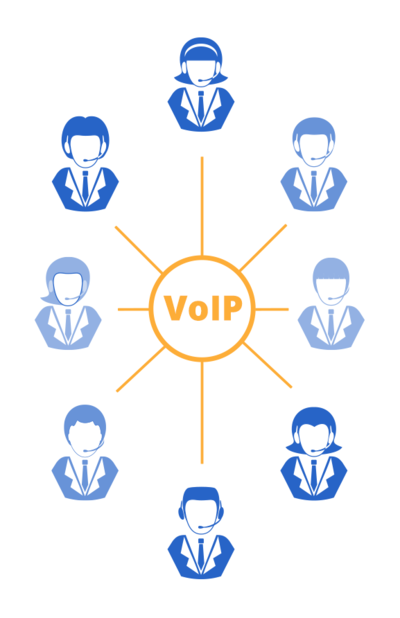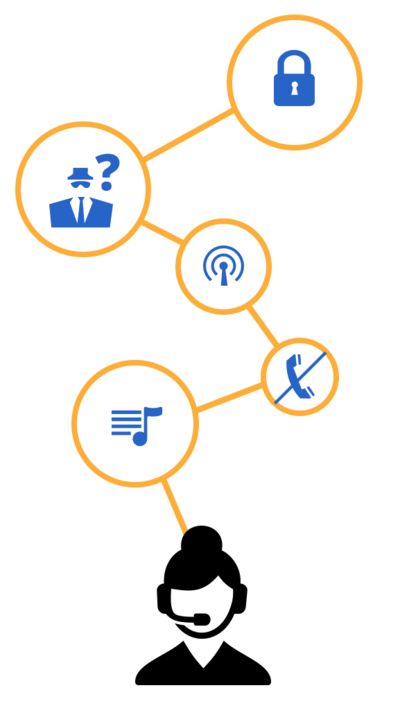
Overview
The Inbound Call Center application is a robust call center solution that offers sophisticated call queuing, skills based agent routing, queue escalation, custom hold music, agent auditing and reporting. Seamlessly integrated into Talking SIP’s other enhanced services, this module's key features include caller queue position and estimated hold time announcements, integration into the Voice Mail and PBX Module to provide callers with the option to leave a message, callback integration to allow caller’s to receive an automated callback from the next available agent, custom branding, full audiotext menu trees for custom queue selection criteria, whisper notification on call agent answer, telephony and web interfaces for agent status management and full integration with Talking SIP’s real-time billing engine for complete and robust billing.
The Inbound Call Center option is designed to support an unlimited number of call centers and/or agents and is ideal for the next-generation VoIP service provider who is interested in capturing high-margin revenues through advanced business-to-business (B2B) and business-to-consumer (B2C) services. Talking SIP delivers an unmatched call center solution that provides the latest in VoIP enabled features so that you, the service provider, can capture business regardless of geographic boundaries.

Features
The Inbound Call Center option is rich on features and branding capabilities providing highly flexible configurations for providing hosted call center services to businesses, non-profits, government agencies, sports teams and more! Provide branded access, music on hold and specific agent routing based on the agent best suited to service the caller.
- Call screening option to require callers to announce themselves before being transferred to an agent.
- Call confirmation option to provide the agent with the option to answer the call, reject the call, or transfer the call to voice mail.
- Automatically exclude registered endpoints with expired registrations from the call out list for greater network efficiency and lag reduction.
- Security option to require a password on access and/or answer.
- Custom branding and professional on-hold music.
- Seamless integration with the Voice Mail and PBX Module as well as third party voice mail systems.
- Talking SIP supports Call Cabinet’s industry leading call recording solutions Atmos and Call Tracker, which are deployable through the cloud, on premise or in a hybrid configuration. Easily and seamlessly record conversations for training, dispute resolution, compliance or security reasons. All calls can be recorded whether directed to PSTN, VoIP or Agent destinations and call recording can be pre-configured on a destination or DID-basis or invoked on-demand through DTMF commands. All recordings are immediately available through the intuitive Call Cabinet web portal with insightful data analytics where the recordings can be played, marked, annotated, and/or downloaded.

Billing & Costing
Talking SIP™’s innovative applications and integrated real-time VoIP billing engine provide unmatched extensibility for designing high margin integrated services that drive profit to the next-generation network, while helping to increase customer loyalty and retention.
- Real-time billing engine integration
- Offer free services or bill by the call and/or by the minute as well as vary the cost of the call over the call’s duration
- Vary the rate based on full or partial ANI/DNIS, access code, and/or based on the time of day, day of week or date range
- Bill subscribers based on DNIS, device, caller or conference access code

Call Queueing
The Inbound Call Center application is designed from the ground up to support an unlimited number of call centers and/or agents. Talking SIP’s call center solution is ideal for the next-generation VoIP service provider that is interested in capturing high-margin revenues through advanced business-to-business and business-to-consumer services.
- Seamless integration with Talking SIP™’s Callback Module to allow participants to save their position in queue and be automatically called back by the next available agent.
- Whisper notification on answer to allow custom information (e.g. service, ANI, DNIS, etc.) to be spoken to the Call Agent to help guide them on how to answer and service the call.
- Option to announce caller’s position in the queue.
- Escalate callers in the queue as well as require user confirmation to remain in the queue.
- Option to provide the caller with the dynamic average hold time.
- Set the maximum number of callers in a queue.

Reporting
Turnkey reporting provides the network operator with the ability to run agent specific reports for performance reviews that can also be used for comparisons with other agents. Supported logging of agent statistics provides further metrics for review and analysis. As a robust and feature rich call center solution, Talking SIP’s additional value is derived from its web and voice based agent status management as well as its seamless integration with its entire service offering.
- Manage Call Agent status via the End User Web Interface or Telephone Interface.
- Full Call Agent logging and statistics.
- Multiple Call Agent and Call Queue reports for management and/or accounting purposes.
What is Inbound Call Center?
With today’s businesses operating more virtually thanks to advancements such as the Internet, e-mail, and the ability for workers to work remotely, the requirements for physical facilities has been greatly reduced but the importance of maintaining the relationship with the customer has only increased with global competition. The Call Center now plays a vital and instrumental role in maintaining the relationship between the business and the customer. Call Centers are responsible for receiving calls from customers, constituents, and field staff members who require sales assistance, technical support, product information, or service diagnostics. The Call Center properly greets and routes callers to the proper queue and agent for assistance, while helping to manage fixed agent resources with the greater number of callers who wish to reach those agents, while providing callers with comfort guidance and custom on hold music. With the Inbound Call Center service routing can be handled on a skills, premium fee, as well as a customer/employee basis.
Traditionally call center agents were located in a common facility and calls routed to them through banks of hard wired phones but this configuration of the past proved expensive due to multi-year lease commitment and the high monthly cost to provide the facilities for the agents, in addition the call center equipment had to be deployed at each call center. With today’s VoIP call center application the callers experience has been greatly enhanced while operating costs have been driven down significantly through the support for remote workers, and through partitioning where the same platform can be used to service multiple companies and/or queues.
Call Center services, whether directly deployed by the enterprise or contracted through a hosted service provider, can service any enterprise anywhere in the world without the need to deploy equipment at each location, nor centrally warehouse agents. Agents now have the freedom to work from anywhere, such as their homes or a satellite office, and as a result the business no longer needs to make the same capital investments in infrastructure in order to operate a Call Center. In addition, with support for many types of calling devices, agents can now receive calls to their PCs, mobile smartphone Wi-Fi/3G clients, regular phone, IP phone or ATAs further reducing the capital requirements need to operate a Call Center.

